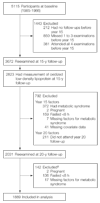Association between circulating oxidized low-density lipoprotein and incidence of the metabolic syndrome
- PMID: 18492970
- PMCID: PMC2562739
- DOI: 10.1001/jama.299.19.2287
Association between circulating oxidized low-density lipoprotein and incidence of the metabolic syndrome
Abstract
Context: Experimental data support the hypothesis that oxidized low-density lipoprotein (LDL) is associated with the metabolic syndrome. However, this hypothesis has not been tested in humans.
Objective: To establish the relation of oxidized LDL with metabolic syndrome in the general community.
Design, setting, and participants: The Coronary Artery Risk Development in Young Adults (CARDIA) study is a population-based, prospective, observational study. We studied 1889 participants who were between the ages of 18 and 30 years at the time of recruitment in 1985 and 1986 and living in 1 of 4 US metropolitan areas (41% African American; 56% women) and were seen both at year 15 (2000-2001, ages 33-45 years) and year 20 examinations (2005-2006).
Main outcome measure: The longitudinal association of oxidized LDL and incident metabolic syndrome. Oxidized LDL was measured with a monoclonal antibody-based enzyme-linked immunosorbent assay. The metabolic syndrome was defined according to the Adult Treatment Panel III of the National Cholesterol Education Program.
Results: Incident metabolic syndrome was diagnosed at the year 20 follow-up in 12.9% (243 of 1889) of participants who did not have metabolic syndrome at the 15-year follow-up. The odds ratios (ORs) for incident metabolic syndrome after 5 years' follow-up and adjusted for age, sex, race, study center, cigarette smoking, body mass index, physical activity, and LDL cholesterol levels by quintiles of oxidized LDL were 2.1 (95% confidence interval [CI], 1.1-3.8) for the second quintile (55.4-69.1 U/L); 2.4 (95% CI, 1.3-4.3) for the third quintile (69.2-81.2 U/L); 2.8 (95% CI, 1.5-5.1) for the fourth quintile (81.3-97.3 U/L); and 3.5 (95% CI, 1.9-6.6) for the fifth quintile (> or =97.4 U/L). The adjusted ORs for incidence of dichotomous components of metabolic syndrome in the highest vs the lowest quintile of oxidized LDL were 2.1 (95% CI, 1.2-3.6) for abdominal obesity, 2.4 (95% CI, 1.5-3.8) for high fasting glucose, and 2.1 (95% CI, 1.1-4.0) for high triglycerides. Low-density lipoprotein cholesterol was not associated with incident metabolic syndrome or with any of its components in the fully adjusted model containing oxidized LDL.
Conclusion: Higher concentration of oxidized LDL was associated with increased incidence of metabolic syndrome overall, as well as its components of abdominal obesity, hyperglycemia, and hypertriglyceridemia.
Figures

References
-
- Isomaa B, Almgren P, Tuomi T, et al. Cardiovascular morbidity and mortality associated with the metabolic syndrome. Diabetes Care. 2001;24(4):683–689. - PubMed
-
- Trevisan M, Liu J, Bahsas FB, Menotti A Risk Factor and Life Expectancy Research Group. Syndrome X and mortality: a population-based study. Am J Epidemiol. 1998;148(10):958–966. - PubMed
-
- Ford ES, Giles WH, Dietz WH. Prevalence of the metabolic syndrome among US adults: findings from the third National Health and Nutrition Examination Survey. JAMA. 2002;287(3):356–359. - PubMed
-
- Ehara S, Ueda M, Naruko T, et al. Elevated levels of oxidized low density lipoprotein show a positive relationship with the severity of acute coronary syndromes. Circulation. 2001;103(15):1955–1960. - PubMed
-
- Tsimikas S, Bergmark C, Beyer RW, et al. Temporal increases in plasma markers of oxidized low-density lipoprotein strongly reflect the presence of acute coronary syndromes. J Am Coll Cardiol. 2003;41(3):360–370. - PubMed
Publication types
MeSH terms
Substances
Grants and funding
LinkOut - more resources
Full Text Sources
Other Literature Sources
Medical

